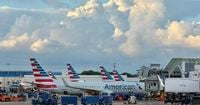Early on the morning of September 28, 2025, a grim discovery at Charlotte Douglas International Airport in North Carolina sent shockwaves through the aviation community and beyond. Maintenance workers, carrying out routine inspections on an American Airlines Boeing 777-200ER that had just completed a transatlantic journey from Frankfurt, Germany, stumbled upon the lifeless body of a suspected stowaway hidden within the plane’s landing gear compartment. According to multiple reports, including those from USA Today and Wings Magazine, the deceased individual was found around 9 a.m., prompting an immediate response from the Charlotte-Mecklenburg Police Department (CMPD).
The CMPD’s Homicide Unit detectives, along with crime scene search teams, quickly took over the scene, launching a full-scale investigation into the circumstances surrounding the death. Operations Command and MEDIC also responded to the incident, ensuring that all necessary protocols were followed as the investigation unfolded. Despite the disturbing nature of the discovery, airport operations continued as usual throughout the day, with officials working diligently to minimize disruption to travelers and staff.
Details about the deceased remain scarce. Neither American Airlines nor the CMPD have released information regarding the individual’s identity, country of origin, or the precise cause of death. The lack of immediate answers has only deepened the sense of tragedy and mystery surrounding the case. In a brief statement, an American Airlines spokesperson confirmed, “We are working with law enforcement on its investigation.” The airport echoed this sentiment, with a spokesperson telling USA Today, “We are deeply saddened by this news and will support the Charlotte-Mecklenburg Police Department’s investigation as needed.”
The incident has reignited conversations about the extreme risks associated with stowing away in the undercarriage of commercial aircraft. Aviation analyst John Nance, speaking to ABC News, painted a stark picture of the dangers faced by those desperate enough to attempt such a journey. “A human body exposed for many hours to temperatures as low as minus 60 degrees Fahrenheit courts extensive frostbite and loss of limbs, even if the utter lack of oxygen at 35,000 feet or more doesn’t result in brain death,” Nance explained. The conditions inside a plane’s wheel well are unforgiving—unpressurized, unheated, and perilously short on oxygen. At cruising altitude, survival is almost impossible.
Experts estimate that roughly three-quarters of stowaways who hide in a plane’s undercarriage do not survive the journey. The fatality rate may even exceed 75 percent, according to analysts cited by Wings Magazine. The reasons are straightforward: at 35,000 feet, the temperature plummets to levels that can freeze exposed skin in minutes, and the lack of oxygen can cause unconsciousness or death in a matter of moments. Even if someone survives the ascent, the descent brings its own dangers, including the risk of falling from the aircraft as the landing gear deploys.
Tragically, this is not an isolated incident. Just eight months prior, in January 2025, the bodies of two Dominican teenagers were discovered in the landing gear of a JetBlue passenger plane at Fort Lauderdale-Hollywood International Airport. The aircraft had arrived from New York, and, as reported by USA Today, maintenance crews found the bodies during a post-flight inspection. The exact circumstances of how the teenagers accessed the plane remain unclear, but their deaths underscored the desperate lengths to which some individuals will go in search of a better life.
Similarly, in December 2024, a body was found in the wheel well of a United Airlines plane after it landed in Maui, Hawaii, following a flight from Chicago. These incidents, though rare in the grand scheme of global air travel, are stark reminders of the humanitarian crises and personal desperation that can drive people to risk everything—even their lives—for a chance at a new beginning.
For many, the discovery in Charlotte is more than just a news story; it’s a window into the global realities of migration, inequality, and the human cost of border security. While aviation security measures have become increasingly sophisticated over the years, the sheer determination of some individuals to escape dire circumstances continues to challenge even the most vigilant systems. As one observer noted, “This kind of thing isn’t seen until it’s too late, and the fatality rate actually exceeds 75 percent.”
Airport and airline officials have expressed profound sadness in the wake of the tragedy. The Charlotte Douglas International Airport reiterated its commitment to supporting the police investigation, emphasizing the importance of compassion and respect for those affected. American Airlines, for its part, has pledged full cooperation with law enforcement as the investigation continues.
The broader context of these stowaway incidents cannot be ignored. While security agencies like the Transportation Security Administration (TSA) work tirelessly to prevent unauthorized access to aircraft, the reality is that some vulnerabilities remain—particularly at large, busy international airports. The hope, of course, is that ongoing improvements in surveillance, perimeter security, and staff training will help reduce the likelihood of such tragedies in the future. Yet, as the recent events in Charlotte, Fort Lauderdale, and Maui demonstrate, the problem is complex and deeply rooted in global socioeconomic disparities.
For those working in aviation, the incident serves as a sobering reminder of the unseen human stories that occasionally intersect with the high-tech world of modern air travel. Maintenance crews, pilots, and airport staff are all too aware that beneath the surface of routine operations, there can sometimes lie evidence of tragedy and desperation. The discovery of a stowaway is always a moment of reflection—on security, on humanity, and on the forces that drive people to such perilous acts.
As the investigation in Charlotte continues, questions remain about the identity of the deceased, the circumstances that led to their fatal journey, and what more can be done to prevent similar tragedies. For now, the story stands as a poignant illustration of the lengths to which some will go in pursuit of hope, and the challenges faced by those tasked with safeguarding the skies.
In the end, the events at Charlotte Douglas International Airport offer a somber reminder of the human cost behind the headlines, and the ongoing need for vigilance, empathy, and understanding in a world where the desire for a better life too often collides with the harsh realities of international borders and air travel.




